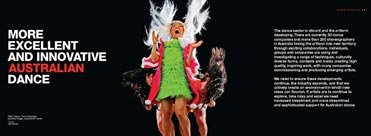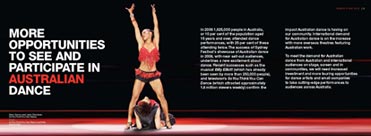By 2012 we will have
- more excellent and innovative Australian dance
- more opportunities to see and participate in Australian dance
- dance as an integral part of every young person’s education
- a range of sustainable careers for dance artists
Cultural diversity and Indigenous cultural heritage are integral to all our ambitions.
More excellent and innovative Australian dance
 The dance sector is vibrant and the artform is developing. There are currently 50 dance companies and more than 200 choreographers in Australia taking the artform into new territory through exciting collaborations.
The dance sector is vibrant and the artform is developing. There are currently 50 dance companies and more than 200 choreographers in Australia taking the artform into new territory through exciting collaborations.The dance sector is vibrant and the artform is developing. There are currently 50 dance companies and more than 200 choreographers in Australia taking the artform into new territory through exciting collaborations. Individuals, groups and companies are using and investigating a range of techniques, culturally diverse forms, contexts and media creating high quality, inspiring work, with many companies commissioning and producing emerging artists.
We need to ensure these developments continue, the industry expands, and that we actively create an environment in which new ideas can flourish. If artists are to continue to explore, take risks and excel we need increased investment and more streamlined and sophisticated support for Australian dance.
Investment
By 2012 we will have a greater range of philanthropic and private investors, commissioning funds from venues and festivals and commercial sponsorship.
Increased investment in established dance organisations will have built reserves and created more new work, and new funding will see more companies supported on a regular basis. We will have a greater philanthropic investment in dance, and we will have dedicated philanthropy managers employed in a number of dance organisations.
Collaboration
By 2012 we will have more collaboration across the dance sector to ensure that resources are shared and diversity encouraged. We will have more formalised collaborations between independent artists and companies of all sizes, offering access to spaces, residencies, mentorships and choreographic commissioning programs. We will have more opportunities for dance artists to forge new collaborations across artforms and borders.
Producers
By 2012 we will have managing and producing services for independent artists and small companies established across Australia. Australian independent producers will have support to build sustainable careers in the domestic and international marketplace. New producers of dance will be recruited from related artforms and the commercial sector to develop and deliver a diversity of productions. We will have forums where producers and presenters come together to discuss solutions to presenting and funding work internationally.
Research and critical debate
By 2012 artists will be supported over longer periods of development and more dance artists will be accessing interdisciplinary arts funding. We will have a range of programs to develop the artform and to discuss the artist’s relationships with audiences, critics and presenters. Dance artists will be benefiting from the work that Playwriting Australia is doing with dramaturges and writers for the stage.
More opportunities to see and participate in Australian dance
 In 2006 1,625,000 people in Australia, or 10 per cent of the population aged 15 years and over, attended dance performances, with 25 per cent of these attending twice. The success of Sydney Festival’s showcase of Australian dance in 2008, with near sell-out audiences, underlines a new excitement about dance.
In 2006 1,625,000 people in Australia, or 10 per cent of the population aged 15 years and over, attended dance performances, with 25 per cent of these attending twice. The success of Sydney Festival’s showcase of Australian dance in 2008, with near sell-out audiences, underlines a new excitement about dance. Recent successes such as the musical Billy Elliot (which has already been seen by more than 250,000 people), and television’s So You Think You Can Dance (which attracted approximately 1.8 million viewers weekly) confirm the impact Australian dance is having on our community. International demand for Australian dance is on the increase with more overseas theatres featuring Australian work.
To meet the demand for Australian dance from Australian and international audiences on stage, screen and in communities, we will need increased investment and more touring opportunities for dance artists and small companies to take cutting-edge performances to audiences across Australia.
National
By 2012 we will have a touring circuit to support regional venues to program adventurous dance work for their audiences. We will have funds for Australian presenters and promoters to attend performances and festivals outside their home states and territories, and a database of audience information to help companies and venues with strategies for audience engagement. We will have more Australian dance in Australian festivals and increased touring of culturally diverse dance.
International
By 2012 we will have an international touring fund for companies to exploit international opportunities. We will have support for targeted international buyers to travel to Australia. We will have created an initiative that supports co-productions between European and Australian presenters and will see ongoing investment into the development of touring circuits in Asia and North America. We will have workshops for Australian dance producers to increase their knowledge and awareness of international markets and a website profiling Australian dance artists, with access to a database of international contacts.
Creative communities
By 2012 we will have improved opportunities for Australians to participate in community-based dance activities. There will be new partnerships between Regional Arts Australia and the Community Arts Networks to develop access and participation programs in isolated communities in cities and towns. We will have direct grants for regional community arts organisations and more dance artists receiving support for community-based dance projects.
Digital
By 2012 we will have greater access to Australian dance through the expanding digital delivery platforms. We will have more live Australian dance recorded and transmitted on the web and digital television channels. We will have Australian dance films featured and promoted on an international web portal. We will have a web 2.0 platform that showcases Australian dance work; operates as a free web tool kit for the arts sector and provides a comprehensive national events calendar.
We will have more dance content for urban screens, mobiles, vodcasts, internet channels and broadcast through partnerships with commercial organisations. We will have greater access to new technologies for dance artists and new research into technology in performance.
Dance to be an integral part of every young person's education
 The current popularity of dance with young people, evidenced by rocketing attendance at dance classes in studios across Australia, offers huge potential for developing creativity and innovation across the curriculum.
The current popularity of dance with young people, evidenced by rocketing attendance at dance classes in studios across Australia, offers huge potential for developing creativity and innovation across the curriculum.Dance is currently an optional component of arts education, and teachers have little opportunity for involvement with professional dance artists and the youth dance sector. The opportunity is huge for dance to be a valued part of every person’s education, offering creative, healthy and stimulating experiences for all Australians throughout their lives.
Curriculum development
By 2012 we will have the benefits of dance clearly stated and understood at every level of education. Dance will have parity with other artforms in the curriculum, from early childhood through to tertiary level. We will have a database of dance resources available to schools and private studios, and more Indigenous input into the development of dance education and resources. The use of new technologies in dance curriculum development will be encouraged where appropriate.
Accreditation for dance educators
By 2012 we will have accredited professional development courses for dance educators at all levels in schools and studios. Nationally recognised teaching standards for dance educators will be delivered through registered training organisations and safe dance practice will be embedded into teacher education programs.
All new physical dance spaces in schools and theatres will meet OH&S standards.
Education and training for artists
By 2012 we will have certified teacher development courses for independent artists. They will have new skills and knowledge about the education sector, enabling them to make creative contributions at every stage of their careers. We will have grants for dance artists and organisations to develop and deliver arts learning experiences through in-school residencies.
Access
We will have improved access to quality artistic experiences for students in primary and secondary schools and tertiary institutions, and youth dance projects that engage young audiences in the arts. Dance will be promoted in communities for its benefits across health, social inclusion, disability and aged care agendas, as well as to the gifted and talented.
Dance to offer a range of sustainable careers
 The dance sector still offers little choice in earning and professional development pathways to individuals who pursue a life-long career in dance.
The dance sector still offers little choice in earning and professional development pathways to individuals who pursue a life-long career in dance.New projects such as SCOPE have started to support dance artists in career management, with 38 participants currently enrolled in the program. The seed funding for this hugely successful project runs out in 2009. The excellent Treading the Pathways project for Indigenous independent dance artists is due to end in 2010.
Dance artists are extremely mobile, and sustainable careers need to include a ‘whole of life’ package that enhances wage parity, superannuation, taxation and social security reform, career development opportunities and the provision of genuine career pathways in dance. Sustained investment in programs for career development, leadership and skills sharing will ensure that the industry grows and matures to match the talent of those it attracts.
Sustainable careers
By 2012 the SCOPE and Treading the Pathways projects will be ongoing and include a greater number of participants over longer periods. We will have mentoring programs that link emerging artists with established companies to build choreographic skills and collaborative processes, and we will extend opportunities for professional disabled artists to develop their dance careers.
Changes in legislation
We will have secured reforms to deductible gift recipient (DGR) legislation to encourage more donations to dance artists and improved copyright legislation to ensure that artists are equitably compensated for creative work. More flexibility in the social security system will capture the peculiar rhythms of employment and career development in the arts sector.
Dialogue and networks
By 2012 there will be regular state and territory forums for the profession, and a regular national conference to sustain and build networks, share knowledge and create new opportunities. Online and print information and communication services will be significantly upgraded. New and existing dance research will be accessible through online services focusing on research and dialogue.
Skills development
By 2012 we will have skills development initiatives to enhance professionalism and remove inefficiencies, including support for young and emerging artists to develop professional skills, expertise and professional networking. There will be a national support network for emerging arts managers and support for long-term career development. Networks will also be developed for independent artists through regular business skills workshops. These will be linked to mentoring programs and projects such as SCOPE and Treading the Pathways.
This plan is supported by government arts funding agencies, the tertiary dance council, dance companies and independent artists, the studio sector, the commercial and community sectors, venues, presenters and producers.


